
The Quest for the Perfect Showerhead
Posted on: May 2017Dr Kemi Adeyeye, University of Bath
 |
Kemi Adeyeye established and leads the Water Efficiency Network. She is also Associate Professor in Integrated Design at the Department of Architecture and Civil Engineering, University of Bath. Her research focuses on integrated strategies for resource efficiency and resilience. Recent projects includes: The Demystifying the Shower Experience. New/upcoming project includes: Solutions for Housing for Displaced people, and REDAWN – water-energy in water networks. |
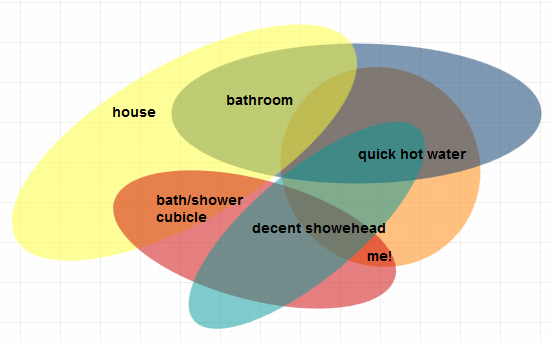 |
A while ago, I asked some folks at a social event, as one does during a conversation lull, what they thought about their shower (The question was deliberately vague). The main responses were: “I like to showerâ€, “nobody takes baths anymore†and, “I can’t do without a shower in the morningâ€. Not one person said that: “I spend 5 minutes or less in the shower you knowâ€, “I am in the top percentile of those that use 35 litres per shower1†or “Showering accounts for about 25% of my household water use2â€. Instead, the conversation went on to discuss shower products and bathroom fittings – bug-bears i.e. dripping taps and ineffective showers in hotel rooms, modern bathroom gizmos that were annoying, new must-have bathroom catalogue recommendations, plumber costs etc. |
I found this interesting, partially because we were just concluding our ‘Demystifying the Shower Experience’ project at Brighton. But also because the project had presented some interesting findings not just about water use efficiency but also about sustainability products i.e. the showerhead itself.
Water-efficient showerheads, including those in our study, come in a wonderful myriad of shapes, sizes, functions etc. So may I ask: do you have a favourite showerhead? Have you, like me, given this any thought? If yes, what is your decision based on? Is it the shape e.g. round, oblong, rectangular? Size, diameter of the head including thick or flat? Material type and colour? Number and type of functions e.g. pulsing, massaging, rain etc.? Number, type and arrangement of spouts? Type, pressure and distribution of sprays? Additional functions e.g. temperature and time display etc. All these design factors inherently influence our perception of the shower – aesthetically and functionally.

Examples of water-efficient shower heads in the study - different shapes, colours, materials and spout sizes etc.
What do we think of when we are in the local DIY store, in search of a new showerhead? Or do people really care? As long as the showerhead does ‘what it says on the tin’ right? I care – a lot actually. In fact, if someone asked me what I thought about my shower, I would go as far as saying that I won’t keep a poorly designed, poor quality showerhead (I have had to pay for one or two as part of my quest), as a poorly performing showerhead is simply annoying, and a decent shower is a fab start to the day!
To this end, I have been on a personal quest for the perfect showerhead over the couple of years. Some of the showerheads and hoses that I have tried - about 10 showerheads during the past 2 years – have at times evoked strong emotional response; in both the positive and negative spectrum! But I won’t self-indulge in a rant about these. Instead, I will present findings from a neutral study (I did not trial these showerheads to avoid bias) and the resulting user feedback.
Satisfying our sociological and psychological needs
Researchers propose that water use efficiency has four main dimensions: physical/environmental, technical, sociological and psychological. We may also have heard sayings like - an eco-product is an eco-product and it is up to the user to use it correctly, or change their habit or behaviours to suit. I think I can guess what most people’s answer to that will be! So why do we continue to turn people off water efficiency by selling or giving them products they won’t like or enjoy? Physical and technological factors inform the extent to which a shower product satisfies our sociological and psychological needs. So it is important to get this right at least.
Studies on sustainability or ‘eco’ products confirm that a functionality mismatch occurs when there is disconnect between the design of a product and the tacit or explicit functionality expectations by the user. This mismatch in turn results in the rejection or poor use of the product, and consequent misuse of the associated natural resource. This in essence confirms what we already know i.e. the success of a water-efficient product is not solely based on water consumption/dispensing values. The true value of a water-efficient product is defined by the extent to which it enhances the user experience – and saves water. But we are all different, and come in various shapes and sizes, so achieving the positive user experience for everyone is not so straightforward.
De-mystifying the Shower Experience
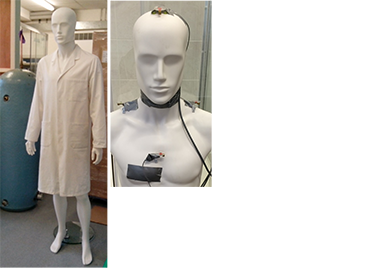 |
So we thought we’d put this to the test as part of the De-mystifying the Shower Experience project and launched a "10 showerheads in 10 weeks challenge". Prior to the challenge, we had put the showerheads through some standard laboratory tests using our lab mannequin – George (left image). |
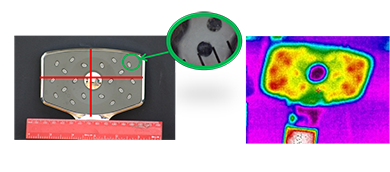
Sample showerhead: Grey and Chrome plastic, recessed twin spouts, twisting radial distribution, colliding twin-jet sprays, 9l/min flow.
The design of the showerhead also informs the spray and temperature distribution to the body. The charts below show spray and temperature distributions from lab tests along the North, South, East, West axis. The left chart of the sample showerhead below shows that higher flows are experienced when standing closer and central to the showerhead than away from it. This distribution profile is informed by a number of factors including the shape of the showerhead as well as the positioning. Below, the right hand chart shows the temperatures as the water from the shower hits the body. The resulting user perception will also be based on body factors including anthropometrics as well as environmental factors e.g. a shower cubicle will heat up over time, so the temperature range in the spray may be less perceived3
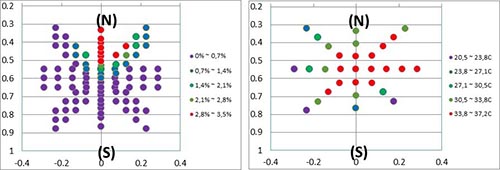
Same sample showerhead: Spray and temperature distribution of water on the body
For the challenge, we recruited 12 participants – 6 Male and 6 Female and gave them a water efficient showerhead to use each week – we had 2 additional participants and showerheads as control. The participants attended a pre- and post-challenge focus group and completed feedback sheets at the beginning and end of each week.
The challenge was an opportunity to examine various factors associated to shower-water use. But it was also an opportunity to conduct a simple heuristic test to explore how experiential feedback on each showerhead compares with lab results.
Briefly, as you already guessed, there was no one-size-fits all showerhead. But we were able to define characteristics that people liked and disliked. For example, we found that the participants were not too bothered about the colour and shape of the showerheads even though the general preference was for the typical round, chrome ones. But we had negative feedback about some showerheads that felt ‘cheap’ and ‘plasticky’. In this trial, it was also noted by the participants that the size of the showerheads was important to ensure enough coverage of the spray. But this depends on the user’s stature and external factors e.g. shower-over-bath or a shower cubicle. Some smaller stature participants, with a shower over bath arrangement did not like the big shower heads because the spray ‘literally went everywhere including the floor and missed the body’. Majority of the participants also prefer their showerheads to have more than one function, but not too many – they like the choice even if they don’t use it often. Showerheads with sprays that are too fine/tiny droplets received negative feedback especially from women – ‘they don’t get conditioner off the hair well’4. Interestingly, once they decided that they did not like the spray, all the fine-spray showerheads consistently received negative feedback from almost all the participants, and for almost all the assessed criteria. So impressions do last - bad impressions last longer.
The highest rated showerhead in the study had 2 functions with an ergonomic slider and delivered water via a generous random array of twin recessed spouts in triple clusters. The jets from the spouts collide turning into more droplets as they arrive at the body. The showerheads in the sample that deliver water mixed with air and have single protruding and rub clean nozzles in a central core and a with radial rows layout (examples below) also received good feedback. Although some users noted they did not like the higher acoustic levels of these types of showers.
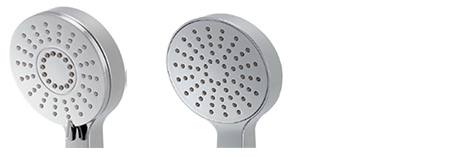
Same showerhead with air mix functions and wipe clean nozzles
So there you have it. I have just been told about a new 2-in-1 showerhead available in the US, so perhaps I'll try that next. In the meantime, please tell us what your favourite shower is and why at http://bit.ly/favouriteshower.
I should conclude by saying that all the showerheads were designed to be water-efficient. We did not find any direct correlation between design factors such as size of showers and duration/amount of water used. The duration of showers were fairly consistent across the group and was found to be more influenced by other factors. But this is perhaps best explained in another blog.
Some further info and technical details about this study can be found here:
Adeyeye, K., She, K., & Baïri, A. (2017). Design factors and functionality matching in sustainability products: A study of eco-showerheads. Journal of Cleaner Production, 142, 4214-4229.
Acknowledgement:
Thank you to Methven, Chandlers Building Supplies Lewes and the participants of the study. The study was funded by the SET RIF fund, University of Brighton.
Footnote:
I should conclude by saying that all the showerheads were designed to be water-efficient. We did not find any direct correlation between design factors such as size of showers and duration/amount of water used. The duration of showers were fairly consistent across the group and was found to be more influenced by other factors. But this is perhaps best explained in another blog.
Some further info and technical details about this study can be found here:
Adeyeye, K., She, K., & Baïri, A. (2017). Design factors and functionality matching in sustainability products: A study of eco-showerheads. Journal of Cleaner Production, 142, 4214-4229.
Acknowledgement:
Thank you to Methven, Chandlers Building Supplies Lewes and the participants of the study. The study was funded by the SET RIF fund, University of Brighton.
Footnote:
- A typical 5 minute shower uses 35 litres of water: taptips.ie/downloads/HowMuchWater.pdf
- Energy Savings Trust report, At Home with Water 1 & 2: http://www.energysavingtrust.org.uk/resources/reports?keyword=at+home+with+water&sort_by=created
- A forthcoming paper will present these findings for each showerhead in the study in more detail.
- Cath Hassell, our Watef blog-meister has informed me that there is a shower on the market that operates on this principle and washes hair well. Feel free to ask her about it: cath.hassell@ech2o.co.uk, test it and let me know if you agree.



